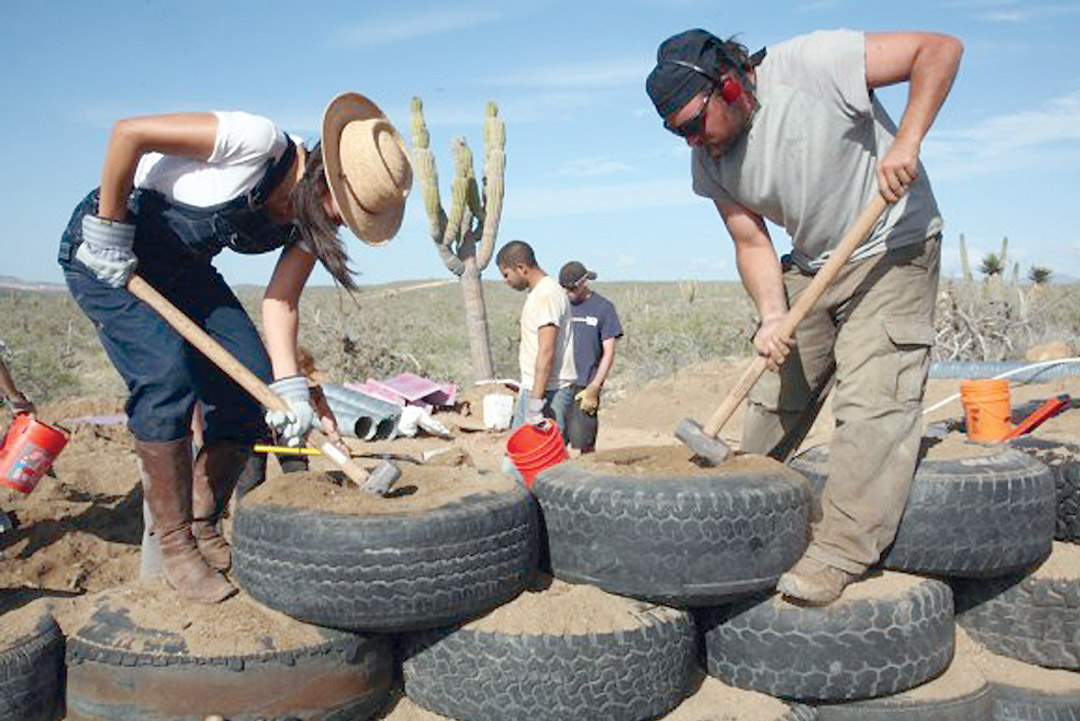Part of being a green contractor means studying emerging technologies offering more eco-benefits than conventional construction. In this case we’re looking at old technologies: the rammed earth wall, one of humanity’s oldest building techniques.
When it comes to walls, a couple of rammed-earth techniques are available as alternatives to your standard insulation-filled 2×4 frames:
The Earthship model uses old tires as receptacles for rammed earth, and then uses them as building blocks for durable, energy-efficient walls. They use waste and locally available raw materials, so the largest investment is labor.

New company Earthco Megablock has developed an automated mechanical system to generate compressed earth blocks. Their materials leave a minimal carbon footprint (but still more than using manpower and recycled tires) and require less manpower to get the job done.

To clarify, I’m only talking about walls here: Both companies use rammed earth to make walls, but Earthco Megablock uses their technology to build “normal” 4-walls-door-and-windows houses while Earthship encompasses a whole sustainable lifestyle. You could, for example, build an Earthship using Earthco’s blocks.
Earthship saves money by relying on networks of volunteers, while Earthco reduces labor costs and building time by streamlining and automating the construction process. Earthship is good for when you have time and people, but no money. Earthco doesn’t require time or people, but you do need money…and somewhere to put their machine.
So if you’re building in, say, Haiti, you’d go with Earthship because it’s easier to truck in volunteers or laborers instead of shipping in a huge honking machine from the U.S…and that’s exactly what happened in the latest Earthship project, which you can see on their website. Meanwhile, in America, there might well be a market for the professional service Earthco has put together.
One of Earthco’s goals is to change green construction from an idealistic collaboration into a commercial presence. To quote from their web site: “While some people are not yet convinced about the need for “green” construction, everyone is into superior quality and saving money.” They have a point: the best way to make green building methods mainstream is to beat the mainstream in price and quality.
The trick is to do this without incurring the hidden costs that typical construction has (one example, the cost of new 2×4 lumber is so cheap because nobody is paying up front for the environmental costs of clear cutting a forest).
We’ve discussed Earthship before, but Earthco is a new find, so here’s a quick summary of their method, followed by some pros and cons:
Giant Compressed Earth Blocks are made by transporting proprietary machinery to your location, where local dirt is squeezed into compressed earth building blocks that are immediately built into walls.
Benefits:
Production is sustainable and affordable. Using local materials and manufacturing on site means almost no carbon footprint. Mechanized placement means less labor. In general, walls can be built at twice the speed and half the cost of conventional lumber construction.
The walls are thick and offer thermal mass that retains heat while blocking wind. Simply replacing lumber/insulation walls with block walls nets you 50% in energy savings. Building to passive house standards (ensuring airtightness) boosts savings to 90%. (But you can achieve similar results with conventional materials, which we’ve done.)
The blocks are virtually indestructible. They’re built to withstand F5 tornadoes, wildfire, and gunfire. In impact testing, a relatively shoddy block wall took a brick traveling at something like 1000 miles an hour. The bullet, of course, disintegrated. The wall hardly took a dent.
Drawbacks:
Simple earth block walls are not suited for areas with high humidity levels, as the blocks are water-resistant but not waterproof. They need to be enveloped in some kind of waterproof outer layer, such as insulation, adobe, or stucco.
You can’t run electricity or plumbing through block walls. You’d have to cut grooves to accommodate wires or pipes, or run them in through the ceiling or floor.
Personally, we wouldn’t be able to make use of this technology because we couldn’t get the machines into a Brooklyn backyard, and we’d run out of local dirt fast. Trucking in the dirt or the blocks would defeat the purpose to some extent. Tire-based rammed earth walls, on the other hand, are feasible because we could work at a smaller scale.
Eco Brooklyn has a rammed-earth wall in the cellar of our green show house. What we did was more like this, because we have people in New York, but we don’t have space, so giant compressed earth block technology wouldn’t be a feasible choice for what we do. We do a lot of retrofits on existing New York brownstones. There isn’t a lot of room for rammed earth construction in our neighborhood, though rammed earth walls can be an aesthetic option.
That said, the most practical green construction method is always the one that makes the most efficient use of resources available to the builder. Other than their use of rammed earth, Earthship and Earthco’s earth block technology are very different innovative green building techniques with the potential to bring green building to different markets.
Eco Brooklyn is a big fan of the Earthship building technique and lifestyle. The Earthco find is a nice addition to our resource list, and a company to keep an eye on.
